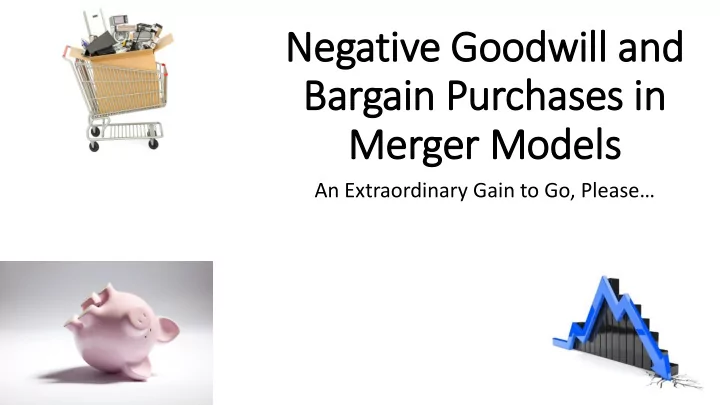

Negative Goodwill and Bargain Purchases in Merger Models An Extraordinary Gain to Go, Please…
Negativ ive Goodwill and Bargain Purchases “Can you explain what happens in an M&A deal if the Equity Purchase Price is less than the seller’s Common Shareholders’ Equity?” “Do you get ‘negative’ Goodwill? What is the accounting treatment for this type of bargain purchase?”
Negativ ive Goodwill and Bargain Purchases • SHORT ANSWER: No, ‘negative Goodwill’ cannot exist under either U.S. GAAP or IFRS – instead, you create 0 Goodwill and record an Extraordinary Gain for ABS(Goodwill) on the Income Statement • Accounting: Purchase Price Allocation is similar, but you may have to create new Intangible Assets “the real way” rather than using simple percentages; and put MAX(0 around Goodwill! • Statements: Record an Extraordinary Gain on the IS; on the CFS, reverse it and reverse the extra taxes the company paid within the Deferred Tax line item • Balance Sheet: Affects Cash, Retained Earnings, and the DTL or DTA
Tutorial Outline • Part 1: Why would a “bargain purchase” ever take place? Who would be dumb enough to sell for such a low price? • Part 2: Why the accounting is confusing, and a simpler way to combine the statements in an M&A deal • Part 3: A real- life example of a “bargain purchase” and negative Goodwill during the last financial crisis (2008 – 2009)
Part 1: Why Bargain Purchase Happen • Typically: The seller is distressed, running low on Cash, has high Debt/other obligations, and needs to sell ASAP • Options: Liquidate and potentially get less than Shareholders’ Equity if the fair market values of Assets are low… or sell to another company • Advantage of a Sale: Keeps the company alive in some form and might result in a higher price than a liquidation • Here: “Coco Cream Donuts” has declining revenue, high CapEx, rising expenses, rising Debt, and a rapidly declining Cash balance – not exactly bankrupt, but needs to do something quickly
Part 1: Why Bargain Purchase Happen • Liquidation: Goodwill will be worth nothing, and the PP&E, Inventory, and AR might be written down – company could easily receive far less than its $312M of SH Equity • Starbucks: Comes in with a solid offer to purchase Coco Cream Donuts for $250M – below its SH Equity, but still 6.4x EV / EBITDA • Starbucks: Doesn’t think the company’s Tangible Assets are worth much, but likes its Intangibles (brand, customer list, and intellectual property) 60% of the Equity Purchase Price goes to those • PPA: Still write off the Seller’s Common SH Equity and Goodwill and adjust its PP&E and Intangibles… and create a new DTL
Part 1: Why Bargain Purchase Happen • BUT you must put a MAX(0 around the Goodwill calculation to ensure that it never turns negative • Extraordinary Gain: This will equal the negative of the Goodwill calculation… and put a MAX(0 around it as well to handle the case where you get positive Goodwill in the deal
Part 2: Why This is Confusing • Old Method: You used to allocate the “negative Goodwill” proportionally to the acquired company’s Assets – and if some amount still remained, you recorded an Extraordinary Gain for that • But: You no longer do that, despite what some sources say – under both main accounting systems, you now just record the Gain • Also: Few, if any, accounting textbooks walk through the full set of changes on the financial statements with a bargain purchase • One Problem: With our method, the BS does not balance immediately after the deal takes place – only happens in the first full year following deal close
Part 2: Why This is Confusing • Does That Matter? In our view, no, not really, because the end result post- transaction is still the same… • But If You Want to Fix It: A simpler method is to simply Credit the Shareholders’ Equity of the combined company with the Extraordinary Gain in the BS adjustments • Skip: Recording it on the Income Statement, the reversal on the CFS, and the reversal of the taxes paid on the Gain • Similar To: Deducting Transaction Fees from Shareholders’ Equity in a deal rather than showing them on the Income Statement
Part 3: Real-Life Example of Negative Goodwill • 2008 – 2009: The apocalypse! Markets crash, banks start failing, and the economy is in recession Lots of distressed sellers • Financial Sector: Westamerica Bancorporation acquired County Bank for… nothing, even though its Net Assets were ~$48M:
Part 3: Real-Life Example of Negative Goodwill • Result: Westamerica recorded a “Gain on Acquisition” on its Income Statement, reversed it on its Cash Flow Statement, and adjusted its Cash Taxes down – just like in our model:
Recap and Summary • Negative Goodwill and Bargain Purchases: Most common in distressed deals when the seller needs to sell ASAP, and the buyer makes a decent, better-than-liquidation offer • PPA: MAX(0 to prevent negative Goodwill, and record a Gain for the absolute value of Goodwill • IS/BS/CFS: Simplest method is to CR SH Equity with this Gain to ensure a balanced BS; more accurate way is to record the Gain on the IS, reverse it on the CFS, and reverse the taxes paid on it • Should You Care? Bargain purchases are very rare; this topic doesn’t matter much outside distressed/restructuring groups
Recommend
More recommend